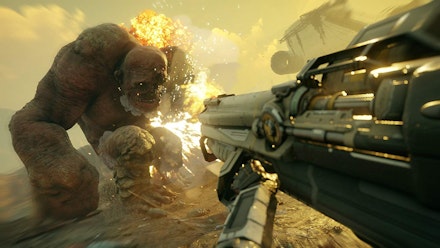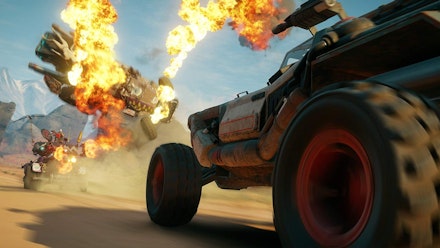Platforms: Xbox One, PS4, PC
When the original Rage launched, way back in 2011, it never quite made the splash it perhaps could have. Despite coming from FPS pioneers id Software and packing in satisfying gunplay and twisted enemies, its yellow-grey post-apocalyse felt overly familiar. Eight years later, and with the help of Avalanche Studios, Rage 2 corrects many of the oversights of the first game.
The main story takes place several decades after the 2011 Rage, pitching players as the last of a group of nanotrite-augmented Rangers. While returning players will cross paths with familiar faces, newcomers won't be lost. If anything, Rage 2 glosses over its set-up – an asteroid wiped out most life on Earth, survivors in arks emerged later, a war happened, now it's clean-up time – in order to throw players into an expansive and often thrilling world.

Avalanche's influence is clear from your earliest steps into the wasteland. Best known for the Just Cause series but also responsible for 2015's excellent Mad Max game, the studio's approach to open worlds and post-apocalyptic wilds makes Rage 2 feel bigger and more interesting. Missions gained from chatting to people in Trade Towns – the game's few oases of calm – slowly pepper the landscape, giving you reason to explore away from the main quest line, while the act of exploration itself reveals alluring '?' locations on the map, just begging to be investigated. The incentive is sometimes needed too, as despite moving away from the sand-blasted yellow-grey wastes of the original to offer some more colourful and diverse biomes, Rage 2's landscapes still rarely inspire – drab, sparsely populated, and seemingly endless, if the quests and mysteries didn't draw you out, you probably wouldn't bother.
Rage 2's combat is a delight, with plenty of ways to dispatch the nastiest enemies the apocalypse can throw at you.
Vehicles feel better integrated into the fabric of Rage 2 though, especially combat-oriented ones. There's a decent variety of motors to find around the world, and any that you manage to safely get back to a Trade Town can then be summoned for a small fee. Once you've built up a decent garage to call upon, some of the game's better diversions are its destruction derby style races, or simply unleashing some vehicular carnage as you roam around.
Still, Rage 2 is ultimately a shooter at heart, and its id Software roots shine through. Every weapon feels great to use, from the simplest pistol to the hefty recoil on the shotgun, and the almost ponderous power of the 'BFG', which fires hugely destructive balls of plasma death. Combined with a slate of satisfying nanotrite abilities offering melee attacks and upgrades to gunplay – the ability to bat grenades back at enemies being a particular favourite – and Rage 2's combat is a delight, with plenty of ways to dispatch the nastiest enemies the apocalypse can throw at you.
However, for a game hyped largely on its anarchic nature, Rage 2 never quite lives up to its own ambitions of delivering a chaotic experience. While there's no real stealth option – there's no sniper rifle, for instance – the game never feels like it's pushing players to barge into enemy dens with a hail of gunfire. Most locations feel like pop-up shooting galleries where you can make your way through with enough ammo to take out enemies as they leap at you – and without the near-total destructibility of Just Cause's worlds, there are no cleverer, more explosive ways to take out encampments.

As a result, most of the missions resolve in linear shootouts through chained, corridor-like areas, making you feel more like an exterminator than a liberator. Even chasing down Arks, where you'll acquire new nanotrite abilities or more powerful weapons, often becomes a routine of clearing out raiders or mutants, then grabbing the swag to tackle tougher 'dungeons'.
Overall Rage 2 is a significant improvement on its predecessor, with a rapid pace of short missions that build up a greater sense of purpose in the world sure to keep most players invested. The design of those missions, mostly reducible to "go here, shoot that", still leaves something to be desired though.
